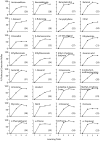Honeybees learn odour mixtures via a selection of key odorants
- PMID: 20161714
- PMCID: PMC2817008
- DOI: 10.1371/journal.pone.0009110
Honeybees learn odour mixtures via a selection of key odorants
Abstract
Background: The honeybee has to detect, process and learn numerous complex odours from her natural environment on a daily basis. Most of these odours are floral scents, which are mixtures of dozens of different odorants. To date, it is still unclear how the bee brain unravels the complex information contained in scent mixtures.
Methodology/principal findings: This study investigates learning of complex odour mixtures in honeybees using a simple olfactory conditioning procedure, the Proboscis-Extension-Reflex (PER) paradigm. Restrained honeybees were trained to three scent mixtures composed of 14 floral odorants each, and then tested with the individual odorants of each mixture. Bees did not respond to all odorants of a mixture equally: They responded well to a selection of key odorants, which were unique for each of the three scent mixtures. Bees showed less or very little response to the other odorants of the mixtures. The bees' response to mixtures composed of only the key odorants was as good as to the original mixtures of 14 odorants. A mixture composed of the other, non-key-odorants elicited a significantly lower response. Neither an odorant's volatility or molecular structure, nor learning efficiencies for individual odorants affected whether an odorant became a key odorant for a particular mixture. Odorant concentration had a positive effect, with odorants at high concentration likely to become key odorants.
Conclusions/significance: Our study suggests that the brain processes complex scent mixtures by predominantly learning information from selected key odorants. Our observations on key odorant learning lend significant support to previous work on olfactory learning and mixture processing in honeybees.
Conflict of interest statement
Figures




Similar articles
-
The olfactory memory of the honeybee Apis mellifera. II. Blocking between odorants in binary mixtures.J Exp Biol. 1994 Oct;195:91-108. doi: 10.1242/jeb.195.1.91. J Exp Biol. 1994. PMID: 7964421
-
Intensity and the ratios of compounds in the scent of snapdragon flowers affect scent discrimination by honeybees (Apis mellifera).J Comp Physiol A Neuroethol Sens Neural Behav Physiol. 2005 Feb;191(2):105-14. doi: 10.1007/s00359-004-0576-6. Epub 2004 Nov 16. J Comp Physiol A Neuroethol Sens Neural Behav Physiol. 2005. PMID: 15711966
-
Reward quality influences the development of learned olfactory biases in honeybees.Proc Biol Sci. 2009 Jul 22;276(1667):2597-604. doi: 10.1098/rspb.2009.0040. Epub 2009 Apr 15. Proc Biol Sci. 2009. PMID: 19369260 Free PMC article.
-
Odour perception in honeybees: coding information in glomerular patterns.Curr Opin Neurobiol. 2000 Aug;10(4):504-10. doi: 10.1016/s0959-4388(00)00109-4. Curr Opin Neurobiol. 2000. PMID: 10981621 Review.
-
Mixture processing and odor-object segregation in insects.Prog Brain Res. 2014;208:63-85. doi: 10.1016/B978-0-444-63350-7.00003-6. Prog Brain Res. 2014. PMID: 24767479 Review.
Cited by
-
Scaling the interactive effects of attractive and repellent odours for insect search behaviour.Sci Rep. 2019 Oct 25;9(1):15309. doi: 10.1038/s41598-019-51834-1. Sci Rep. 2019. PMID: 31653955 Free PMC article.
-
Segregation of Unknown Odors From Mixtures Based on Stimulus Onset Asynchrony in Honey Bees.Front Behav Neurosci. 2019 Jul 12;13:155. doi: 10.3389/fnbeh.2019.00155. eCollection 2019. Front Behav Neurosci. 2019. PMID: 31354447 Free PMC article.
-
Brain and behavioral lateralization in invertebrates.Front Psychol. 2013 Dec 11;4:939. doi: 10.3389/fpsyg.2013.00939. Front Psychol. 2013. PMID: 24376433 Free PMC article. Review.
-
A multimodal approach for tracing lateralisation along the olfactory pathway in the honeybee through electrophysiological recordings, morpho-functional imaging, and behavioural studies.Eur Biophys J. 2011 Nov;40(11):1247-58. doi: 10.1007/s00249-011-0748-6. Epub 2011 Sep 29. Eur Biophys J. 2011. PMID: 21956452 Free PMC article. Review.
-
Odorant cues linked to social immunity induce lateralized antenna stimulation in honey bees (Apis mellifera L.).Sci Rep. 2017 Apr 7;7:46171. doi: 10.1038/srep46171. Sci Rep. 2017. PMID: 28387332 Free PMC article.
References
-
- Laska M, Teubner P. Olfactory discrimination ability for homologous series of aliphatic alcohols and aldehydes. Chem Senses. 1999;24:263–270. - PubMed
-
- Laska M, Galizia CG. Enantioselectivity of odor perception in honeybees (Apis mellifera carnica). Behav Neurosci. 2001;115:632–639. - PubMed
-
- Sachse S, Rappert A, Galizia C. The spatial representation of chemical structures in the antennal lobe of honeybees: steps towards the olfactory code. Eur J Neurosci. 1999;11:3970–3982. - PubMed
-
- Smith B. Analysis of interaction in binary odorant mixtures. Physiol Behav. 1998;65:397–407. - PubMed
-
- Laloi D, Roger B, Blight MM, Wadhams LJ, Pham-Delegue M-H. Individual learning ability and complex odor recognition in the honey bee, Apis mellifera L. J Insect Beh. 1999;12:585–597.
Publication types
MeSH terms
Substances
LinkOut - more resources
Full Text Sources

